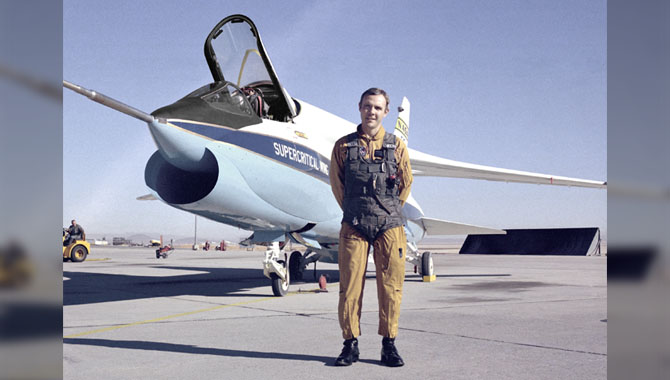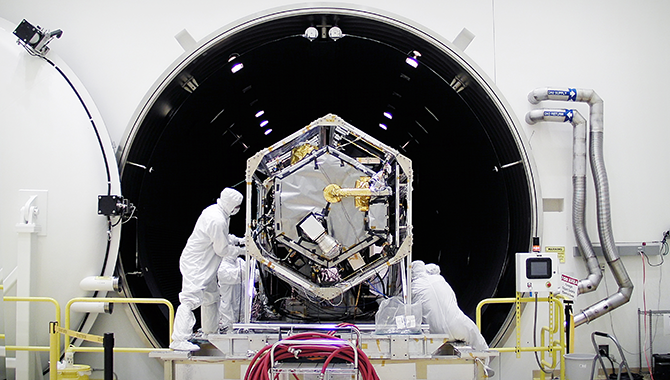
Project pilot Thomas McMurtry stands in front of the F-8 SCW in 1972.
Photo Credit: NASA
Forty-five years ago this month, the first flight of NASA’s F-8 Supercritical Wing Project marked the start of increased speed and fuel efficiency across the aviation industry.
Airplanes have been flying at subsonic and supersonic speeds since 1947, when U.S. Air Force Captain Chuck Yeager first broke the sound barrier in a Bell X-1 rocket plane. But efficient transonic flight—just at, or immediately above or below, the speed of sound—proved more difficult to master.
The problem was drag. As an airplane approaches Mach 1, the speed of the airflow around it generates shock waves that cause the flow of air along the plane’s surface to separate, producing turbulence. This increases drag, which either slows the plane or forces the pilot to burn more fuel to maintain the same speed.
Initially this was seen as a problem for aircraft—usually military planes—approaching the sound barrier. But even planes traveling more slowly are affected. Due to the shape of a conventional airplane wing, air flowing along the wing moves quickly and can approach supersonic speeds even if the plane itself has not reached Mach 1. This occurs because the upper surface of a conventional wing is rounded to enhance lift, which has the side effect of accelerating air flow over the wing’s surface.
To combat this problem, Richard Whitcomb—then-Chief of the Transonic Aerodynamics Branch at Langley Research Center (LaRC)—began investigating new wing designs. Whitcomb had already made a substantial contribution to aircraft design in the early 1950s: the area rule. This concept addressed the problem of transonic drag by introducing a novel airplane fuselage design. Whitcomb determined that by reducing the thickness of the fuselage, drag was reduced, enabling a plane to pass the sound barrier more quickly and smoothly than before.
In the 1960s, Whitcomb began working on a blunt-edged airfoil design intended to delay drag in aircraft traveling at subsonic speeds. Called the supercritical wing (SCW), it was flatter on top and more rounded on the bottom than a conventional airfoil, with a downward curve at the upper trailing edge. Whitcomb hypothesized that these design alterations would reduce the speed of air along the surface of the wing, weakening the shock wave, while providing needed lift at its tail. The result would be reduced transonic drag with a corresponding increase in speed and fuel efficiency.
NASA put Whitcomb’s theory to the test in the early 1970s during the F-8 SCW Project. The two-year flight test program, which operated at Dryden Flight Research Center (now Armstrong Flight Research Center) from March 1971 to May 1973, began on March 9 when project pilot Thomas McMurtry took off in a Vought F-8A Crusader that had been modified with a SCW. The new wing, built by North American Aviation, increased the plane’s wing span from 35 feet, 2 inches to 43 feet, 1 inch. On that first flight, which lasted 50 minutes, McMurtry focused on exploring the stability and handling of the novel wing design.
Over the course of the next two years, McMurtry and nine other pilots took the F-8 up 85 more times. The plane handled well at all transonic speeds, displaying a stability that aircraft with conventional wings couldn’t achieve in the transonic region. The efforts of the F-8 SCW Project team validated Whitcomb’s hypothesis and established that a SCW could increase transonic efficiency by up to 15%, significantly reducing the demand for fuel over a given distance.
SCWs are now commonly used on most modern subsonic commercial aircraft. McMurtry, who eventually became the co-project pilot on the 747 Shuttle Carrier Aircraft and later the Associate Director for Operations at Dryden, received NASA’s Exceptional Service Medal for his work on the F-8 SCW Project. In 1974, Whitcomb was recognized for his work on the SCW design when he received the Wright Bothers Memorial Trophy from the National Aeronautic Association.
Watch a video showing the first flight of the F-8 SCW on March 9, 1971.
Read an APPEL News article about another Whitcomb design that advanced the aviation industry.
Explore an APPEL News article about award-winning innovations—including the area rule—developed at the National Advisory Committee on Aeronautics (NACA), the predecessor to NASA.









